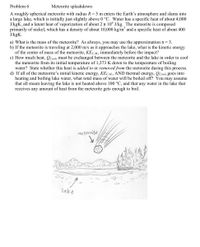Question
2010Q6: Please answer all parts in specific detail and explain each step with reasoning

Transcribed Image Text:Problem 6
Meteorite splashdown
A roughly spherical meteorite with radius R = 5 m enters the Earth's atmosphere and slams into
a large lake, which is initially just slightly above 0 °C. Water has a specific heat of about 4,000
J/kgK, and a latent heat of vaporization of about 2 x 10° J/kg. The meteorite is composed
primarily of nickel, which has a density of about 10,000 kg/m² and a specific heat of about 400
J/kgK.
a) What is the mass of the meteorite? As always, you may use the approximation T~ 3.
b) If the meteorite is traveling at 2,000 m/s as it approaches the lake, what is the kinetic energy
of the center of mass of the meteorite, KEC.M, immediately before the impact?
c) How much heat, QCool, must be exchanged between the meteorite and the lake in order to cool
the meteorite from its initial temperature of 1,373 K down to the temperature of boiling
water? State whether this heat is added to or removed from the meteorite during this process.
d) If all of the meteorite's initial kinetic energy, KEC.M., AND thermal energy, Qcool, goes into
heating and boiling lake water, what total mass of water will be boiled off? You may assume
that all steam leaving the lake is not heated above 100 °C, and that any water in the lake that
receives any amount of heat from the meteorite gets enough to boil.
meteorite
lake
Expert Solution
This question has been solved!
Explore an expertly crafted, step-by-step solution for a thorough understanding of key concepts.
This is a popular solution
Trending nowThis is a popular solution!
Step by stepSolved in 2 steps

Knowledge Booster
Similar questions
- How can find g? And what does it mean to compare my results to the actual value of 9.80 m/sec2arrow_forwardPls solve this question correctly instantly in 5 min i will give u 3 like for surearrow_forwardFuqua X F 12PM SPAN 101 Instructions to X www-awu.aleks.com/alekscgi/x/Isl.exe/10_u-lgNslkr7j8P3jH-IBjuJnuCDtT6kRBabGFF MATH AND PHYSICS Solving an equation of the form logba = c Solve for X. logx 1 100 Simplify your answer as much as possible. X = =0 = -2 log 00 VHL Central | Code Activatio X Olog O No solutionarrow_forward
arrow_back_ios
arrow_forward_ios